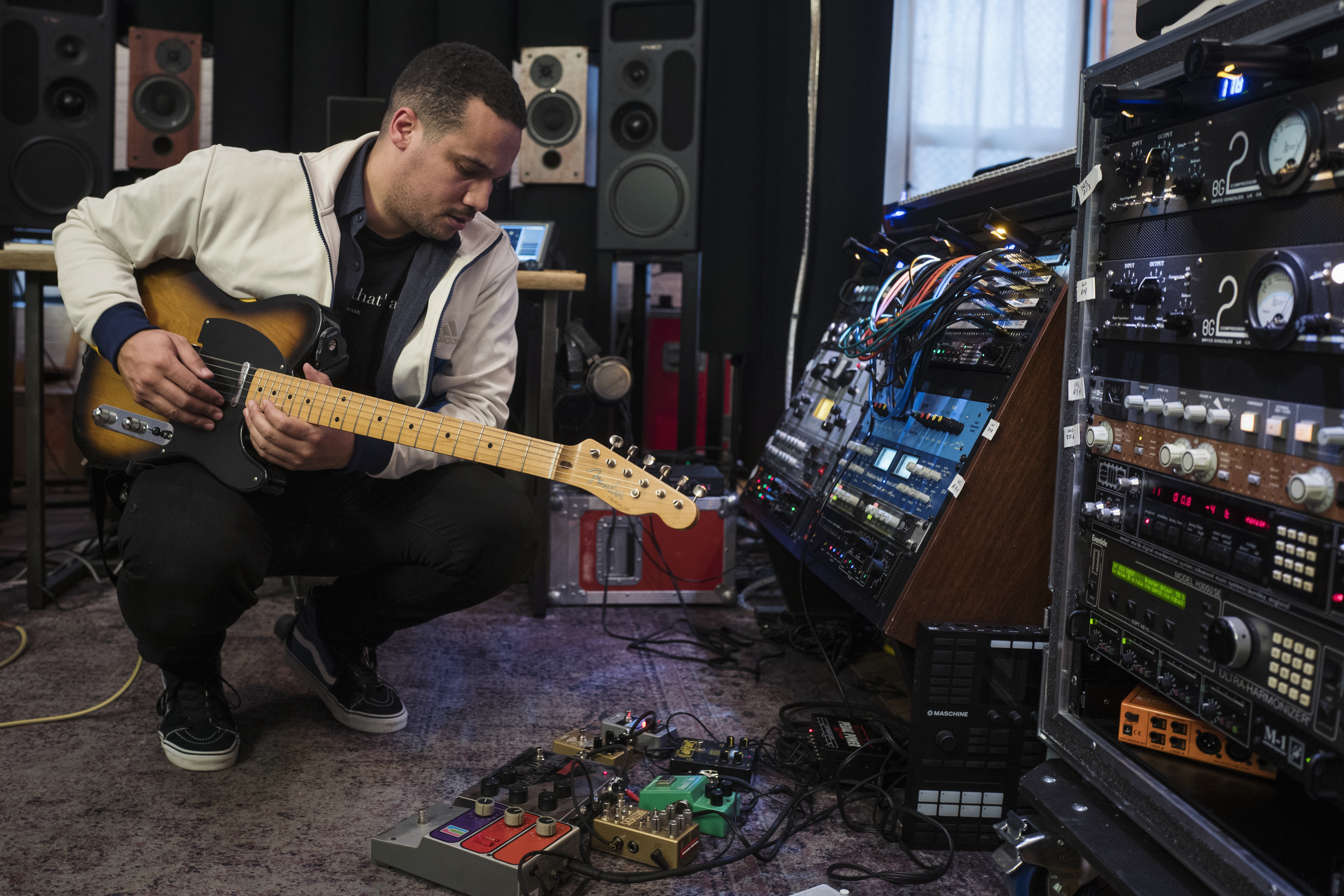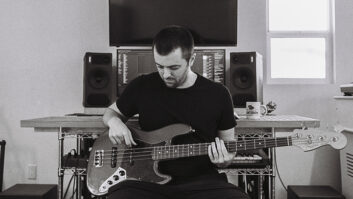It’s a pretty simple thing to twist a knob or ride a fader. Harder, though, is moving them all in the right combination to the right place to get the sound just so. And the “just so” depends on who is at the helm—the big-picture producer, the technically precise engineer, or the feel-for-it mixer. It must be even more difficult when all three of those types inhabit the same body, as they do with multi-platinum producer/mixer/engineer Chris Tabron.
Tabron got his start as a multi-instrumentalist in the electronic-pop band The Ten Paces and as a DJ, but soon found himself behind the board in various capacities. In addition to a stint as senior house engineer at Brooklyn’s Future Shock Studio, owned by Grammy-nominated producer/engineer Alex Newport, Tabron has produced or mixed records by Beyoncé, Mary J. Blige, Common, The Strokes and Erykah Badu. He also has added studio owner to his list of hyphenates, with his own Brooklyn-based studio, Rumours.

So how does he keep it all straight? We caught up with Tabron in between cross-country trips to gain insight to the creative process he uses in each of his jobs.
Mix: How has your diverse background influenced your production style?
Chris Tabron: When I think about what a producer is, it’s just somebody that takes an idea and makes it real. I started out DJ’ing, and I learned how a lot of different songs go together back to back, and how that affects the energy in the room without knowing anything about the people in that room—they’re all in this space and you’re conducting the energy for the room. That’s how I approach production.
I want to do what’s right for the song. Songs are not dissimilar from people—they’ve all got their personalities, they’ve got their quirks, and they’ve got their strengths. I usually look at a song from that lens. It comes down to how is the best way to articulate this idea and get it to a point where as many people as possible are going to identify with it and find something in it for themselves.
What about your mixing style, working on a song that already exists?
It depends on the song that you are mixing. First, I have to figure out what they want me to do and why they called me before I really even sit down with it. Sometimes it’s an artist that usually mixes their own stuff and they just need a different paradigm—they want somebody to see it in a different perspective. The Son Lux record I recently did is a great example of that. Ryan [Lott], the founding member of Son Lux, mixes all his records, and I wasn’t doing anything particularly technical that he couldn’t do himself; he’s a very talented guy. I think he just wanted a different perspective sonically from someone that wasn’t living with it for the past six or seven months.
Related: Chris Pelonis, Music, Design and a Life of Truth and Passion, by Tom Kenny, Mix, Aug. 1, 2014
If it’s a larger-scale pop record, then the producer’s rough mix or reference mix is going to be pretty dialed in. And they’re coming to me for a more technical thing to make sure it’s going to sound good in the car and on the radio and on a headphone ear-bud-type situation. So I’m not going to take as many creative liberties in that situation. I’m just going to make sure that it bangs and that the vocals jump out of the speakers.

How do you work with an artist to understand what they need and guide them to where they want to be?
I do one of two things, and there’s no rhyme or reason to it. Sometimes I’ll listen to their previous stuff and see what they like, and then sometimes I go on a media blackout and I don’t want to hear anything—especially if it’s an album where it’s a turning point for that artist. I don’t want to be influenced by preconceived notions.
I have a very specific process that stays the same no matter what the project is: I listen to the reference mix after my assistant preps it. I just sit on the couch—I’m not even near Pro Tools—and I play the reference and take notes longhand on a piece of paper. You can type quicker than you can write with your hand, and I like that it takes me longer to write something so that I’m not playing catch-up with the song. I want to react to the song the way a listener would, and I only get one shot to listen to something for the first time.
Most of my notes are not technical at all. They’re like: “Is the second verse compelling enough?” “Make sure we maintain the confidence throughout here.” “The transition payoff needs to really hit here in the second chorus.”
I want to get into that holistic way of thinking because a lot of it is going to be so technical, and I have things that I know I need to do that I’m just checking off. Typically, the technical aspect of a mix will be second nature to me, and I work to keep my head in the emotional space of the song.
When you’re mixing, you don’t want to get mired in the technical and miss the feel; the audience doesn’t care how rare the piece of gear you’re using is … or, as I like to say, “No one’s singing along to your snare sound.” I know how I want it to work, but ultimately it’s not about gear or really even the process—it’s about the song. I also like to get the artist or producer to talk about their song or album in as emotional or impressionistic of a way as possible. I really love it when I get collages or images of things that inspired the record, and most of the time I’ll print that out and put it up in my studio so I can try to tap into the same head space.
Related: When Sessions Reigned Supreme: The Players, Studios from L.A.’s Golden Age, by Robyn Flans, Mix, Oct. 1, 2014
What about once you start recording or mixing?
Luckily I’m fast enough that I can start mixing and keep that cadence. I’m just mixing top down; I’m not doing a lot of soloing and I’m not stopping. I’ll isolate an element if I’m trying to fix something, but mainly it’s just sort of top down and let’s go, let’s just do some broad-strokes and let’s get things feeling how I want them to feel. I learned that a lot from my early days doing hip-hop sessions where there’s almost always a party in the control room. You’re mixing, but you’re also controlling the vibe of the room so there’s no looping or stopping, and if you have to solo something, you better do it on beat!
So after about 45 minutes of doing some general mix ideas and exploring, I print a reference mix. Now, that mix is atrocious—certainly nothing that ever gets to another human. But it is a snapshot of my first instinct. So the snare might be 4 dB too loud and the background vocals may be weird—I haven’t even dealt with them yet—but there’s something exciting about them. So how do I capture that excitement but also make it not distracting? I’ll listen to that early mix reference because there’s something there before you get too familiar with it because you’re in a similar place as the audience when they hear the song for the first time.

Seeing as we’re moving over to the technical side of your brain, let’s talk about your personal studio, Rumours.
My studio is in Bushwick, in the ever-gentrifying Brooklyn, New York. The studio serves two purposes: It’s where I do a lot of preproduction and writing, and it’s where I mix. So it covers the very early stages and the final stages, and everything else in between I can go somewhere else. Basically it’s a big loft, maybe 700 square feet or so. It’s not huge, but big enough for me to have all my gear and instruments and a nice little lounge area. And I don’t have to really worry about sound propagation because young kids either live or work in the building and they’re having parties that are louder than me anyway.
I’m on the first floor, so street noise does come through, but that, in an odd way, helps me focus. Being in a room that is completely dead silent is great for recording and for doing really critical things such as cleaning stuff, but I like that there’s a little bit of street noise or a little bit of people and life going on around me.
What gear did you choose to put in your room?
I have what I would call a modular or hybrid setup. I don’t have a console, but I use a Dangerous 2-Bus+ as my summing amp and I mix in one of three configurations. I’ve got two Pro Tools | HD I/Os—one of them is 16 I/O and the other one is 8—so I either do 24 hardware inserts, or 16 summing and 8 hardware inserts, or I go completely in the box.
Related: Classic Tracks: Tom Waits “I Don’t Wanna Grow Up,” Barbara Schultz, Mix, Feb. 6, 2015
Most of my outboard gear, with two exceptions aside from effects, are just compressors. To me, that’s the one thing that software has gotten closer with, but it’s still just falling short, particularly on a bus level when you’re sending a lot of things in parallel to a compressor. I guess I sort of miss the copper, for lack of a better word. But I think digital EQs are fantastic.
The two gear exceptions are a Neve 33114 mic pre/EQ that I can use as a pre, but typically use for mixing, and I have an NTI EQ3. And that’s about it for outboard that’s not compression. I’ve also got an AMS RMX 16 reverb, an H3000, and a pile of old guitar pedals that are also lots of fun to integrate into my workflow.
You seem to be a fan of compressors. What’s your favorite?
I just got some Highland Dynamic BG2s and, since putting them into my rack, they’ve been on every single mix. One of them just stays on a vocal parallel and the other is usually on bass parallel. Sometimes I’ll send the kick drum and the bass to it to get things to come together and gel a bit. I used them once on a drum bus without the compression in circuit, and you can just hit the transformer, which is quite nice, too. But really they are seeing heavy use on parallel duties for either vocals or some sort of percussion or bass thing.
I also just really like the Dangerous compressor—it’s awesome. I use it mainly in parallel on piano. It’s one of those compressors where you’ve got to ignore the gain reduction meters because you have this conception where, you think, “Wow 15 dB is quite a lot,” but it does this crazy thing where you don’t hear those artifacts. For example, a resonant and sustained piano is the hardest thing to compress without getting ugly, but if the left hand of the piano player is not consistent, you’d need to level off those dynamics and figure out a way to get that envelope to be a little bit more consistent. And the Dangerous just does it in a way that you don’t get that 500Hz honk coming out of things. When I first got it, I was confused by how transparent it was.
What do you use to monitor?
I’ve got quite a few sets of speakers, but my mains are PMC IB2S-A’s that I got toward the middle of last year. That was a big step for me because I had PMC TwoTwo.6s for years, and they were a security blanket where I worked on them and things just sounded great. Then Maurice [Patist, president, sales and marketing USA, PMC Loudspeakers] flew out and set up my rig. He’s said, “Just do a whole mix on the IB2S.” And it was tough because even though it’s literally one of the head guys at PMC telling me it’s going to be okay, I hate change. With monitors, it is like you’re asking a racecar driver to change his tires. But I did it. And it was great. It was like my TwoTwo.6s, just on a bigger scale. I’ve got ProAcs and a Chord Amp, and I also use a mono Auratone with a Bryston. And then in the lounge I have a passive set of Behringer Truth speakers and a first-generation Beats Pill to check mixes on.
What about microphones?
I’m lucky enough that I get to work with a AKG C12 or Neumann U47 or whatever I want in most places. I also get to work with amazing vocalists where the mic really is just capturing a stunning performance. When recording vocals, I want their headphone mix to be so good that it sounds like the record with just that little piece of the puzzle missing—which is them. I don’t want them to have to imagine what it will sound like when it’s done; I want it to sound so good they almost forget they’re in the studio. I’ll do little tricks like ride the reverb or delay send while we’re tracking so the vocalist feels like the space is responding to a particular moment in the song.
Related: The Village, Los Angeles: Creative Community of Producers, Artists and Engineers, by Tom Kenny, Mix, Oct. 4, 2016
Usually singers get three knobs: Volume, Track and You. Sometimes I’ll split out effects if they’re particular about certain sections, but I don’t want them fiddling with the mix. I don’t want them thinking about that. I know I’m in a good place when they haven’t touched the box the whole time we’ve been cutting. That means it feels right. To me it’s about putting the vocalist in a place where they’re able to do what they do best.
Where can we hear you next?
I am working on a couple of records that are being produced by Robin Hannibal. It’s great because every time I work with Robin, the arrangements are so dialed in—and arranging is the first mixing in a lot of ways. And then the vocal sounds like honey coming out of my speakers. Great. Let’s bring up the drums. Yes. Those are really tastefully played and the strings are perfect. You’re not worried that the cello, the bass, and the piano are all playing the same thing. With Robin it’s just expertly done and I can enhance his vision.
Chris Tabron: christabron.com, @Tabnetic







